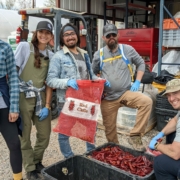Identifying Waste: Becoming a Lean Farming Machine
 Print This Post
Print This Post
By Hakeem Holmes, NCAT Agriculture Specialist
Lean is a business process improvement concept that focuses on the elimination of non-value-added activities from processes, which are defined as waste. These activities may appear in agribusiness operations as processes that do not change the form or function of a product or service being offered. There are eight common forms of waste that can be found in processes no matter the industry: defects, overproduction, waiting, non-utilized talent, transportation, inventory excess, motion, and extra processing (downtime). Monitoring these common forms of waste in farming operations can assist you as an agribusiness professional in streamlining practices, reducing costs, and boosting your bottom line.
Defects
When looking to identify defects in your processes, find final products or services that you produce that do not meet the intended requirement or reasonable expectation of use by the end user. Once a defective product or service is found, a best practice to reduce the number of defective items produced is to examine each activity in the workflow to ensure that people, machines, and other materials used in the creation of product or service are optimized and used correctly. On-farm examples of defects include diseased fruits, blemished vegetables, off-grade milk, or low-quality wool. Great ways to reduce defects can include investment in employee training, implementation of sustainable pest management techniques, and soil testing to optimize growing conditions.
Overproduction
A farmer who hasn’t secured enough market share or hasn’t properly estimated consumer expectations may be experiencing a type of waste called overproduction. Producing more than is needed or producing faster than the next stage of value-added processing can lead to overproduction. Overproduction can lead to a farmer incurring additional costs to their operations such as storage fees, reduced prices due to oversupply, and food waste. Strategies that can be implemented in a farmer’s operation to reduce overproduction are consumer demand forecasting, adjusting planting and breeding cycles based on market trends, and finding ways to create additional products from the excess that is produced.
Waiting
Waiting is a form of waste that is nearly impossible for a farmer to avoid. Planting, harvesting, breeding, raising livestock all require a period of waiting, but there are forms of waiting that can be minimized in farming operations, such as equipment repair, delayed harvest times due to unavailable labor, and delays of shipments of agricultural inputs. The main antidotes to reducing wait times are proper planning and scheduling of activities. The planning process should include building partnerships with consistent suppliers, investment in reliable equipment, and continuous improvement to workflow processes.
Non-Utilized Talent
Maximizing the potential of your current employees can improve your farm output. Non-utilized talent is a form of waste found in operations that results when employee skills and talents aren’t appropriately applied to the processes they manage. Allowing input from employees when designing the workflow of processes on how they are implemented will allow them to have their individual talents shine through in your farm’s operations.
Transportation
Excess movement of materials, livestock, and produce on your farm can quickly cause your operation to incur costs. Transportation waste can appear in many ways on your farm, such as irrigation, field layouts, or even how your livestock are transported to new pasture. Strategies to reduce transportation waste include optimizing field layouts to minimize the distance used by your tractors and travel in your irrigation systems, and implementing precision agriculture technology that can assist equipment in choosing pre-plan routes that optimize distances traveled.
Inventory Excess
Too much of a good thing can lead to waste in your farm operation. Excess inventory may seem like you’re preparing for a rainy day, but you’re actually incurring costs, such as storage and depreciation of equipment and materials. Inventory comes in many forms: raw materials (seeds, fertilizers, breeder livestock), finished goods, and work-in-progress. Goods waiting to be transformed or converted to another form are considered work-in-progress. This is a common form of inventory buildup in farm operations that can be reduced through implementation of just-in-time inventory management practices and forecasting of required materials.
Motion
Motion is a form of waste caused by the humans involved in farm operations performing unnecessary movements while completing tasks. This form of waste is commonly overlooked due to it being written off as a part of the process. Examples include farmers walking long distances to fetch tools, equipment requiring manual adjustments instead of automation, and inefficient layout of farm buildings leading to extra steps. Similar to reducing transportation waste, optimizing farm layout for efficient workflow, investing in automated equipment where feasible, and implementing ergonomic principles can reduce unnecessary movement.
Extra-Processing
As farmers, we want the end user to have the best products or services. Unfortunately, this leads us at times to bring products and services to end users with extras they may not necessarily require or value. This form of waste is known as extra-processing. Excessively washing or polishing produce beyond what is necessary for cleanliness or appearance, over-packaging fruits or vegetables in multiple layers of plastic or cardboard, and thoroughly grading and sorting produce into narrow size or quality categories when a broader range would be acceptable are forms of extra processes that can lead to increase labor costs, wasted resources, damage to products, and higher prices for end users. Extra-processing can be minimized by understanding customer needs and wants by performing market surveys, finding ways to efficiently package goods, and training employees to identify forms of extra processing steps.
Identifying waste is an ongoing process that should be a part of your farm operation’s continuous improvement plan. The eight forms of waste discussed here do not appear in isolation, and if one form is identified, it is usually accompanied by another. Being a lean farming operation will help maximize production and output no matter the size agribusiness you operate.
Related ATTRA Resources:
Evaluating a Farming Enterprise
Planning for Profit in Sustainable Farming
Other Resources:
How Does Lean Six Sigma Eliminate Waste?
This blog is produced by the National Center for Appropriate Technology through the ATTRA Sustainable Agriculture program, under a cooperative agreement with USDA Rural Development. ATTRA.NCAT.ORG.




 USDA
USDA
 USDA photo by Lance Cheung
USDA photo by Lance Cheung

 USDA
USDA